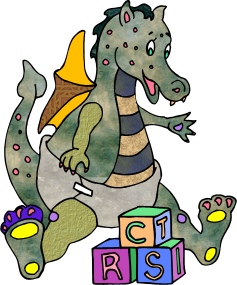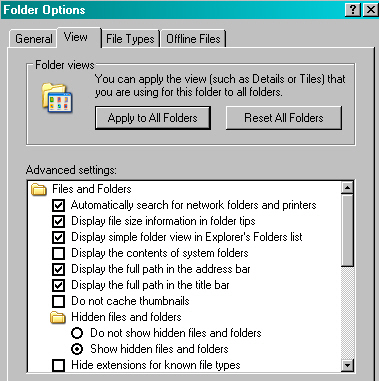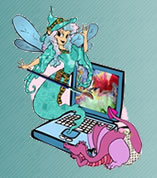Making Mr. Mouse Behave ...
The best advice to anyone having problems double clicking "Mr. Mouse" is to RELAX! Let your hand rest comfortable on the mouse, with your index finger on the left button and your middle finger on the right. Don't let your fingers curl. Keep them extended. When you double click your left mouse button, do it as though you could give a flying flip whether it works or not. It works every time (almost)! When you can relax and not over-control the mouse, your entire computing experience will improve.
Another question usually at the top of a new mouse user's list is when to left-click, right-click, and double-click. The answer is that it will become instinctive after a short while, but in the meantime, these few short "rules" should help.
- Left clicking once usually selects, or highlights an icon or file.
- If you left click once on a button, something will happen. It usually isn't necessary to double click on it.
- Double clicking with your left mouse button on a file or icon will make something happen, usually opening a program.
- Right clicking on anything is intended to give you other options, which you can then choose with your left mouse button. I wish I could tell you that right clicking works everywhere, but it doesn't. It does work in an awful lot of places, more in Windows 95 than in 3.1 and even more now with Windows XP and Vista. You really need to experiment with it to see what it can do for you. It is amazing and can be quite a surprising timesaver in most instances.
 File Names ... File Names ...
File names can also be a curse for some computer users. Users of Windows 3.1 were supposed to use the "8-letter" file name rule (no caps, no spaces), while newer Windows users are re told that almost "anything goes" when they are ready to name their files.
A teensy weensy problem (don't you just love it?) arises when a document created with a newer Windows computer is opened on a really old Win3.1 computer. The file name may be a bit strange, with a ~ stuck in it somewhere. This is because Win3.1 can't recognize those long file names, even if it is able to open the document. Unless you know you will never need to open files on an older computer, you still need to think in terms of short file names. At the very least, make sure the first eight letters are as descriptive as possible.
Special Note: Even though there aren't very many old Windows 3.1 computers out there any more, you never know when you might see the ~ and odd file names. It can also be caused by older software running on a newer computer. Even though the computer is new, the software may not be able to handle those long file names as well as other software can. It is always a good idea to keep file names without spaces and as short and descriptive as possible.
 File Extensions ... File Extensions ...
While Windows doesn't exactly encourage you to put file extensions (.txt, .doc, .bmp, etc.) on your documents and other creations, you still need to consider their continued use. Without an extension, you will not be able to double click on it to open it from your "My Computer", "File Manager", or "Explorer". The extension tells your computer what kind of file it is, so the program it needs to run will open automatically. This keeps you from having to open the program first, clicking File/Open, and pilfering through a mini File Manager looking for it.
When Windows is installed on your computer, you will not be able to see the file extension. I suppose they wanted to save us from ourselves. You have to choose that option by right clicking on My Computer and choosing Explore. Click the word View, and choose Options. Windows ME and newer users need to click the word Tools, then Folder Options to get to this area. Click on the View tab. Make sure Show all files and Display the full MS_DOS path in the title bar are both checked. When you are finished, lock in your changes, by clicking the OK button at the bottom of this screen. We are responsible adults, aren't we?
Keyboard Shortcuts & Mr. Mouse ...
Does it seem as though you are reaching for that mouse most of the time you spend on your computer? Are you frustrated at having to grab it just when your fingers are getting warmed up on the keyboard? Well, here are a few keyboard shortcuts that may just save the day! Your mouse won't be growing moss on it from lack of use, but at least you will be less likely to develop carpal tunnel syndrome from over-clutching Mr. Mouse.
If you would like to select everything on the page you are working on, use CTRL+A. This means that while holding down your CTRL key, press the A key. You should see everything highlighted at this time. If you would like to copy it to your clipboard for use in other programs, use CTRL+C. If you would like to cut (erase the original and put it on your clipboard for use elsewhere), use CTRL+X. When you have your cursor where you want to place what you have copied, use CTRL+V. This sure beats the heck out of reaching for the mouse, clicking the word Edit, then Copy, then Paste, three different times. These are pretty standard keyboard commands for very common actions. You will also find that these same keyboard commands will work the same way in most other Windows applications.
You are all probably pretty with the little arrows on your keyboard. They move your blinking cursor to the left, right, up, or down when you are editing text. Did you know that by holding down the SHIFT key while you use your arrows that you can highlight text? Talk about control! Try it for yourself and see how much easier it can be. There are just some things that respond better to finger power!
Do some prowling around in your software applications. Click on the words at the top of your menu bars in your different programs. You will see different options drop down for each menu item. Next to a lot of these drop-down options you will see a keyboard shortcut for it. Now that you know how to use them, you're ready to give poor old Mr. Mouse the vacation he deserves.
So many new computer users have a miserable time making friends with their mice. Just when they think they have control over the little bugger, it slips off the screen. They will slide it over a bit more, and a bit more, until they run out of mouse pad, or in extreme instances, the table.
You don't have to be a contortionist to make your mouse behave. When it begins to wander, lift it about 1/2 inch off the pad. Bring it back to about the center and place it down again. Note that I did not say to grab it with your right fist, raise it to a level of 12 inches and slam it back down in the center of the mouse pad. This is not the proper way to treat the little fellow, even if you are trying to teach him proper mouse etiquette.
Stay out of trouble ...
When you are exploring in Windows (and you should!), there will be plenty of places that could cause problems if the wrong things are clicked. You could accidentally "save" changes you aren't even aware you made by simply clicking the OK button. When you need to get out of something without making any changes, let the CANCEL button be the one you choose. You will still be a lady or gentleman at the end of the day and no harm will have been inadvertently caused. Think of all the trouble you won't be getting into!
Got questions?
Search mrswizard.com and compuquicktips.com
with Google!
|


 File Names ...
File Names ... File Extensions ...
File Extensions ...